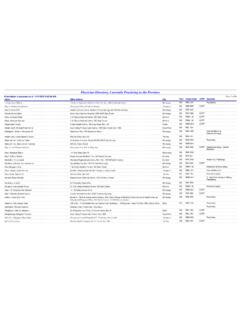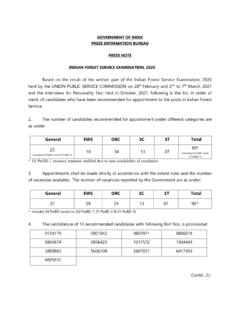Transcription of Questioning Techniques and Teachers’ Role in the ... - ed
1 ShanlaxInternational Journal of Educationshanlax#SINCE1990 Techniques and Teachers Role in the ClassroomGanesan Shanmugavelu1*, Khairi Ariffin2, Manimaran Vadivelu3 Zulkufli Mahayudin4 and Malar Arasi Sundaram51 Senior Lecturer of History, 3 Senior Lecturer of Science Education, 4 Senior Lecturer of Educational Studies, 5 Senior Lecturer of Social StudiesInstitute of teacher Education (Ipoh Campus), Malaysia2 Associate Professor of History, Sultan Idris Education University, Malaysia* aim of this study is to discuss the efficacy of Questioning Techniques of the teachers in the classroom. Proper Questioning Techniques are important in the teaching and learning process.
2 Proper Questioning Techniques will make it easier for teachers to get feedback from students whether or not they understand the subject. This article describes some of the Questioning Techniques that a teacher needs to know to possess in classroom teaching and learning sessions such as attention, suitable voice. Pause, question content, and distribution of questions. This is important for enhancing student motivation and promoting positive, critical, and creative thinking among students and to improve the teaching and learning process in the : Questioning , technique , Classroom, Teaching, Learning and RoleIntroduction As an educator, teachers are constantly engaged with students in teaching and learning activities while teaching a subject in the classroom.
3 One of the most important sessions conducted by a teacher in the teaching and learning process is the question-and-answer session. Questioning is an important activity in teaching. Questioning can be used to test the knowledge of the past, with questions requiring factual answers by asking who, what, where, and when. Designing is also aimed at stimulating student thinking. These kinds of questions need to be carefully considered as they relate to more serious matters such as consequences and to use questions of how and reason. ( , 1985: 310) In the question-and-answer session, teachers can practice a variety of Questioning Techniques and reinforce to motivate students and encourage their thinking in the classroom.
4 Questioning is one of the most effective ways to get students involved in the delivery of the lesson. By asking questions, teachers can engage students to think about the content of a lesson and simultaneously get feedback from students to demonstrate the effect of teaching. (Atan Long, 1980: 135) Questioning skills are very important for a teacher , and its very complex. If these skills are used effectively, the performance level of students will increase, and the teaching and learning environment will become more active and more encouraging. (Eee Ah Meng, 1989: 332).OPEN ACCESSM anuscript ID: EDU-2020-08043260 Volume: 8 Issue: 4 Month: SeptemberYear: 2020P-ISSN: 2320-2653E-ISSN: 2582-1334 Received: : : : Shanmugavelu, ganesan , et al.
5 Questioning Techniques and Teachers Role in the Classroom. Shanlax International Journal of Education, vol. 8, no. 4, 2020, pp. : This work is licensed under a Creative Commons Attribution-ShareAlike International LicenseShanlaxInternational Journal of Education shanlax#SINCE1990 Techniques One of the key components to creating effective teaching and learning processes is the method of Questioning or Questioning Techniques used by teachers. Questioning by teachers in the teaching and learning process is one of the many interactions that occur in the classroom. Questioning Techniques are one of the tools for achieving goals and stimulating students mental activity.
6 Questioning Techniques is important because it can stimulate learning, develop the potential of students to think, drive to clear ideas, stir the imagination, and incentive to act. It is also one of the ways teachers help students develop their knowledge more effectively. Teachers need to be aware that the quality of questions and the quality of the Questioning when conducting teaching and learning sessions in the classroom are one of the key elements in determining the effectiveness and quality of their teaching sessions. To help students stimulate a high level of thinking, teachers must play a key role in applying the right Techniques and skills to question students.
7 Teachers should be aware of any changes that occur in the classroom, and those changes should be aligned with the objectives they want to achieve in the teaching and learning process. Teachers, therefore, need to plan carefully and take into account some of the following factors:(i) Attention Questioning is one of the most effective ways to make the students pay attention in the classroom. About this, the question must be addressed to the whole classroom before a student is asked to answer. (Atan Long, 1980: 142). Teachers should also ask a question first before mentioning the name of a student to answer the question posed. This is to ensure that all students are focused on the questions that are posted.
8 If the name of the student is mentioned first, only that particular student will pay attention in the class. Teachers should always ask questions to all students in the classroom and not just to the students who raise their hands. In this case, the teacher should not be influenced by the behavior of the students who raise their hands when asking a question. Often, teachers only ask questions to the students who raise their hands and do not focus on students who did not raise their hands. This is not good in the teaching and learning process. Attention and care should be given to all the students in the classroom. (Atan Long, 1980: 142) In the meantime, some students who are not paying attention will ask the teacher to repeat the question.
9 In this case, the teacher should not repeat the question posed when asked by the student to repeat it. If the teacher repeats the question, then, of course, the student will not pay attention, so to attract the students, the teacher should mention the question only once.(ii) Voice One of the most important communication tools for a teacher is voice. When asking questions, teachers should make sure their voices are clear and that their tone is well-heard. The questions should be presented well and clear to the students and look forward to receiving answers. This is important to attract students to answer a question.
10 (Atan Long, 1980: 143)(iii) Pause After submitting a question, the teacher should be the one to pause talking for a moment and look at the whole class. Note the verbal cues that indicate that the student is ready to respond. (Sharifah Alwiah Alsaqoff, 1983: 214) After asking questions, students should be given time to think about the answers. The time given should not be too long because if it is too long, the interest in it will fade.(iv) Content of Questions In asking a question, a teacher should plan the types of questions that will be asked in the classroom. In this case, it may not be necessary for these questions to be prepared in advance, but the axis question needs to be designed.
















